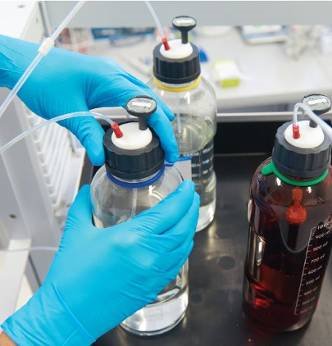Solvent products are used in a wide variety of applications, including pharmaceuticals, electronics, and chemical manufacturing. The typical scientific laboratory is home to a considerable range of chemicals that require careful storage and appropriate use. In short, they present a constant challenge to the community in terms of solvent safety.
According to the European Solvents Group, approximately 5 million tonnes of solvents are sold in Europe each year, to more than half a million companies. The European solvents industry is committed to meeting the highest safety and environmental protection standards, and spends more than €20 million per year on research and development.
Capping the benefits
Safe solvent storage and handling are especially important in laboratories using high-performance liquid chromatography (HPLC).
Organic solvents commonly used in HPLC include the following: acetonitrile, methanol, methylene chloride, trifluoroacetic acid, chloroform, hexane, and ethyl acetate. These solvents are flammable, toxic, and carcinogenic, so they must be managed safely. Bottles of HPLC solvents are sometimes “sealed” with aluminum foil or film, or left completely open, which results in exposure to hazardous solvent vapors. Regulations require that containers of hazardous waste be closed and sealed, except when adding or removing waste. Using faulty caps endangers both people and the environment and is also time-consuming, inaccurate, and wasteful.
What's the risk?
• Harmful vapor may be emitted.
• Loose seals may result in dangerous leaks – and the loss of valuable substances.
• Sensitive fluids; bottles, and laboratory equipment can become contaminated.
• Tubes may become loose and interrupt processes.
• Changing containers can become a risky procedure.
• Shrinkage of mobile phase can occur due to evaporation.
Stay safe solution
Stay Safe caps, available via a private label partnership, can prevent solvents from leaching into the air—protecting everyone who might otherwise be exposed. Stay Safe caps also promote mobile phase consistency. Over time, solvent density can change, affecting chromatographic results. Storing solvents with airtight caps prevents this problem, ensuring the long-term consistency of the mobile phase, and the chromatographic results. In addition, loss of material, whether by spill, leakage, or evaporation translates directly to economic loss.
Stay safe advantages at a glance
• Protect employee health.
• Save money by preventing leakage and evaporation of expensive solvents.
• Optimize solvent replacement with freely rotating cap design.
• Achieve drip-free collection of used or contaminated media.
• Prevent harmful gas emissions via charcoal filters.
• Ensure timely replacement using time strips
• Improve chromatographic results.
More information available here
For Research Use Only. Not for use in diagnostic procedures.
Keywords: Stay safe caps; mobile phase; HPLC; Liquid chromatography; HPLC solvents; chromatography; solvent storage

